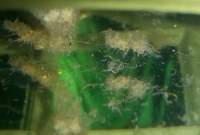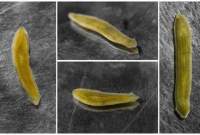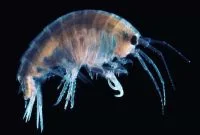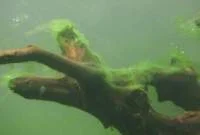Red algae are one of the older algae species on our planet. They are typically multicellular organisms scientifically identified as ‘Rhodophyta.’
Primary, most of these algae types are found in marine and brackish tanks, but they can also live in freshwater environments under certain conditions.
Audouinella (Black Brush Algae/BBA) and Compsopogon coeruleus (Staghorn Algae) are genera parts of Rhodophyta. These two algae are often present in tropical aquarium setups and frequently bane by many hobbyists.
However, some aquarists let the BBA develop on rocks or woods to create a realistic view in their tank.
This article will discuss another freshwater red algae species that rarely seems to thrive in an aquascape tank, red spot algae (Hildenbrandia).
TABLE OF CONTENTS
Is Red Spot Algae Dangerous?
Generally, most aquarists considered algae as ‘weeds,’ and many discussed it as the main topic on the web forum because they bring more disadvantages than beneficial when they appear in the tank.
Simply, weeds are plants that most people do not want to grow. Especially, the algae family from the Rhodophyta division is tough to control, making the hobbyists frustrated.
The information about red spot algae probably is seldom shared by other aquarists in both web topics or discussed on the forum, as once these algae have less chance to develop in the tank. So only a little few tank keepers were facing them.
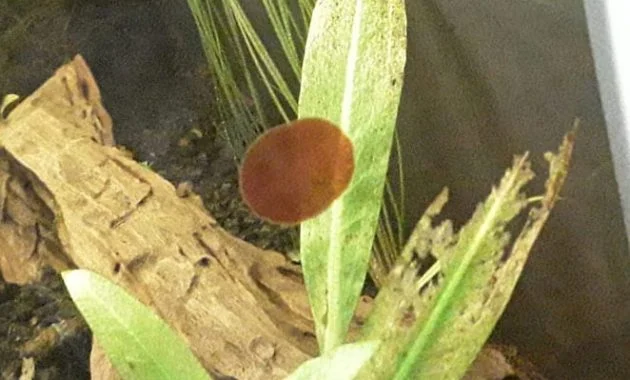
According to scientific studies on researchgate, there are six freshwater Hildenbrandia usually found in nature, including H. rivularis, H. angolensis, H, arracana, and H. ramanaginaii, H. jigongshanaensis, and H. Japanese.
One or more species of them suspected causes the red-spot algae are emerging in the planted aquarium.
In their natural habitat, they mainly inhabit running or calm water streams. These algae commonly live in rivers, lakes, or ponds.
Tropical Hildenbrandia species can tolerate extreme temperatures, ultra-violet light, and desiccation. It’s making them become a difficult enemy to fight in the aquarium.
When invading the aquarium, the red spot algae usually sticks tenaciously, coating the leaves or decorations, creating a red layer above it. They can also cling to the tank glass, forming a reddish-brown circle.
They are relatively growing slower to cover the entire space in the aquarium, so you will have sufficient time to look for an effective way to get rid of them.
Such as other red algae (Coralline algae) often seen in the saltwater or reef tank, you will need a high effort to fight with them.
If a small population of red spot algae invasion your tank, do not be panic. Having a little piece of any algae type is ordinary; with a rule, you can still handle their growth.
But, if they begin out of control, you should discuss it soon with the experts to find the proper method against them.
Read Also: How To Stop Green Dust Algae Grow In The Aquarium
Is The Red Spot Algae Dangerous For Fish?
Like most algae that often attack in planted tanks, they are actually not too dangerous to the fish and other creatures. For a couple of fish and shrimps species, they may become an extra snack in leisure.
However, you surely never want it if your tank turns to poor red color in appearance. Leave the algae to absorb all nutrients in the water and make your plants die.
After that, the producing oxygen process will decrease significantly, making your fish suffer.
Read Also: The Best Ways To Beat Fuzz Algae In The Aquarium
Common Causes Of Red Spot Algae
You might be curious about what kind of problem stimulates them to spread in the aquarium.
And you are lucky; come to the right place where everything related to red spot algae will be discussed in this article.
Learning everything about these rare and unique freshwater algae will help you protect your tank from their invasion. It is also helpful to identify what kind of method you should do if your tank is infected by them.
Based on several sources of information, below is some reason that causes these algae to live in your planted aquarium:

They Brought Into The Aquarium When Introduced New Fish Or Plants
This is the most likely reason for inviting the red spot algae to grow by introducing new plants or water from the fish bag that was contaminated with them.
Some unseen tiny filaments probably cling to new added aquatic plants or float in the water and are born as the new spores in the new aquarium.
Once they are deposited into a compatible tank environment, these algae could establish.
Read Also: How To Get Rid Of Green Spot Algae In An Aquarium
Unstable Nutrients
The unstable macronutrients always become the main element that causes almost all types of algae to appear.
Higher iron and nitrates levels in the water are often associated with red spot algae appearance. Some aquarists believed the object that can promote it go up is utilizing soil under the substrate.
Too Much Lighting Duration And Spectrum
Higher nutrients with too much lighting duration and spectrum, while your tank has insufficient aquatic plants to absorb, will give a chance to red spot algae to thrive.
These factors are also valid for other freshwater aquarium algae types.
Read Also: How to Stop Green Hair Algae Growth in a Fish Tank
Deficiencies Of CO2 And High Temperature
In their wild habitat, red spot algae tend to be found in a specific stream with clean water, constant nutrients, contain low CO2 and extreme temperature levels.
When your tank condition meets these requirements, maybe those factors push the algae to grow.
How To Control Red Spot Algae
You can apply these several methods below to control and avoid the red spot algae bloom in your tank. Let’s see the list:
Quarantine Any New Species
New aquatic plants, fish, shrimps, and snails have to pass the quarantine phase. It aims to kill any parasite, fungus, and bacteria sticking on them.
Placing the fish in the separate tank was added aquarium salts and aerated for 1-2 days depending on the species types and conditions.
Remember always to waste the water from the fish bag. Ensure to clean any tank equipment used from other tanks before applying them in the new tank using bacteria remover.
Do a disinfection bath to new aquarium plants before being introduced to the tank with mixture bleaching liquid for 2-3 minutes. A typical dosage that is usually used by most aquarists is 1part of bleach mix with 19 parts of water.
This mixture also can use for bathing the decorations such as stones, woods, caves, and any aquarium equipment.
Read Also: 5 Effective Ways To Get Rid Of Ramshorn Snails In The Aquarium
Control The Red Spot Algae With Algae Eaters
We thought the existence of any algae eaters species is critical when keeping an aquascape tank.
They can reduce even remove all algae, making your aquarium always perform well. Some of them also have a nice appearance that makes you never bored when watching them.
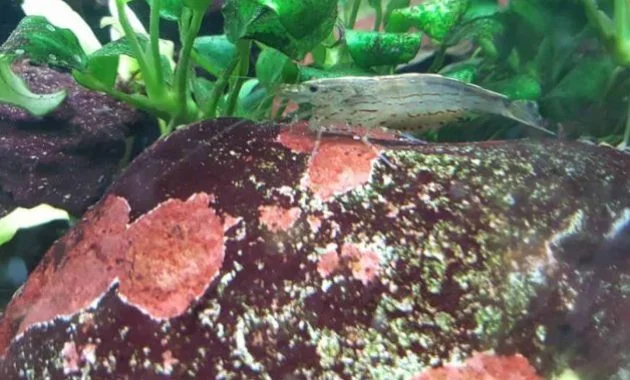
Keep this in mind; not every algae eaters species you found in the trades accepts all algae types. Every species has its own tendencies.
Crossocheilus siamensis, popularly called ‘Siamese algae eaters‘ and nerite snails, suggested having a stunning performance to fight with the red spot algae.
Various shrimps species may prevent new young growth; when the algae are established, they tend to be less effective.
We recommended using SAE due to its high effectiveness; they also effectively eradicate the black beard algae well.
Read Also: Clea Helena The Assassin Of Aquarium Pest Snails
Keep Your Tank Always In Good Standing
Doing regular maintenance is the key to keeping your tank always healthy. Checking any types of equipment frequently, not overfeeding your fish, regular water changes, checking the nutrients, and constantly siphoning the aquarium waste presently is a series of activities you must do to take care of your tank.
That may seize your time and energy, but the results never lie. If you really love your hobby, any complex problem would be faced with happily.
How To Get Rid Of Red Spot Algae From Your Aquarium
There is some technique to remove the red spot algae inside the tank. It can be applied to depend on algae growth level.
So before you try to wipe it, you should observe your tank conditions before; after that, you will know what kind of method that appropriate to kill them. Let’s learn all of the techniques below:
Read Also: Are Axolotls Good Pets For You?
Scrubbing The Red Spot Algae Manually
Eliminating them using algae scraper tools is the easiest and the first step you should perform. For small weed populations, it is pretty effective in reducing their growth level.
It’s probably not clean all spores; they will be back and invade your tank again. So you should combine this first step with the next steps. At least, the algae are disappeared for this time being.
Put More Algae Cleaner Crew
Adding more algae cleaners is the simple next step from scrubbing algae manually. Same with the statement above, SAE fish is most efficient in exterminating and stopping the algae from spreading again.
You can put 2-4 fish or how much you want to guard your tank. Ensure you also provide more space in your tank for other populations. Do not make the SAE stress or get bullied by other species.
So, it’s essential to better understand your tank population before adding a new algae eaters crew.
Read Also: Licorice Gourami: The Unusual Blackwater Fish
Ensure The Nutrients Always Stay Balance
A primary point that causes the red spot algae invasion is the imbalance of macronutrient elements. From this sentence, you will understand what kind of job you should do.
Use the nutrients checker to find the imbalance substance. After that, purchase the fertilizers that are needed. Drop a few doses and keep watching the progress.
Returning all compounds to the formerly conditions healing up your tank quickly. Below is the formula that can use as the reference:
- Phosphate= 0.1-1 mg/l
- Nitrate= 10-25 mg/l
- Magnesium= >10 mh/l
- Potassium= 5-10 mg/l
Read Also: COMPLETE Blackwater Fish Tank Setup Guide
Enhance The CO2 Dissolved
Increasing Carbon dioxide levels help stop spotted red algae survival in the planted tank. Raise it slowly from the day to other days until it achieves the maximum rate.
This is the purpose of avoiding your fish stressed because of the oxygen deficiencies in the water. In our experience, a sudden rising CO2 content makes our fish struggle to breathe because of too much-dissolved carbon dioxide.
Utilizing a CO2 checker is vital to know deeper and easily control this substance. 20 until 30 mg per liter of water is the standard formula most aquarists use.
Do A Water Change
Frequent water change, trimming the overgrown plants, and cleaning all dirt are powerful methods to beat the algae.
Removing the infected leaves using aquarium scissors is another good idea. Cutting the older leaves is also suggested can reduce the chance of spreading the more significant algae.
Use the aquarium siphon tool to pick up organic waste and feces from the substrate. That became essential points that supported algae to develop.
If the red spot algae growth looks more dangerous, you can perform an extreme water change to treat them by reducing almost 75% water in your tank. After that, boost it with aquarium fertilizers and CO2 injection.
Read Also: The Best Aquatic Plants For Blackwater Aquarium
Treat The Red Spot Algae With Liquid Carbon
Utilizing liquid carbon almost works for almost all types of freshwater algae. Injecting 3-5 ml doses routine can hold the algae growth level.
Perform this for a few days until the algae are gone. This liquid commonly sells at affordable prices in local or online shops. As long as you give sufficient doses, this liquid is not dangerous to other tank creatures like fish or shrimps.
Reducing Light Intensity And Water Temperature
Lighting duration, spectrum intensity, and temperature level are also suggested as red spot algae causes.
Decreasing the period and spectrum of lighting is a simple way you should do. Using an intelligent aquarium LED lamp becomes more accessible to set up.
You can lower the temperature level by using a chiller or adding ice wrapped with plastic bags or containers into the aquarium. Installing a thermometer system to monitor the temperature quickly.
Some aquarists do an extreme blackout for 1-3 days to fight with them, but the results it’s not too effective.
Read Also: Freshwater Amazon Pufferfish Caresheet
Check Your Water Circulation
Some algae types thrive well in dead spot areas inside the aquarium, where they cause by lousy water circulation, including this hildenbrandia.
It means the fresh water cycled from the filter should be reached every space inside the aquarium, spreading the macronutrients to every plant.
A large aquarium is prone to having some dead spots if using a weaker filter system; choose the suitable equipment even you can add a small powerhead to increase the flowing levels.
Use Distilled Water
Tap water generally contains heavy iron (Fe) and other metal substances, which is a point that frequently drives the red spot algae to develop.
This water type should be avoided; instead, use distilled water, its contents are suitable to replace the wasted water when performing a water change.
To save more money, you can buy a simple RO water kit exclusively for aquariums than purchasing a new bottled distilled water at the stores.
Read Also: The Best Leaf Litter For Dark Water Aquarium
Use Chemical Controls
We do not advise doing this method, but if you feel to surrender, using algaecides might become the treatment of last resort.
Algae control products are known to work well when killing red spot algae in the aquarium, but on the other side also harm some aquatic plants (especially soft-leaved plants), so you should use medicine with caution.
This treatment does not give much effect to some hardy plants such as Cryptocoryne, Anubias species, Microsorum, Echinodorus, and others.
Algaecides also remove other algae species at once. Significant water change before adding the medicines will improve the remedy’s effectiveness.


